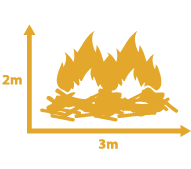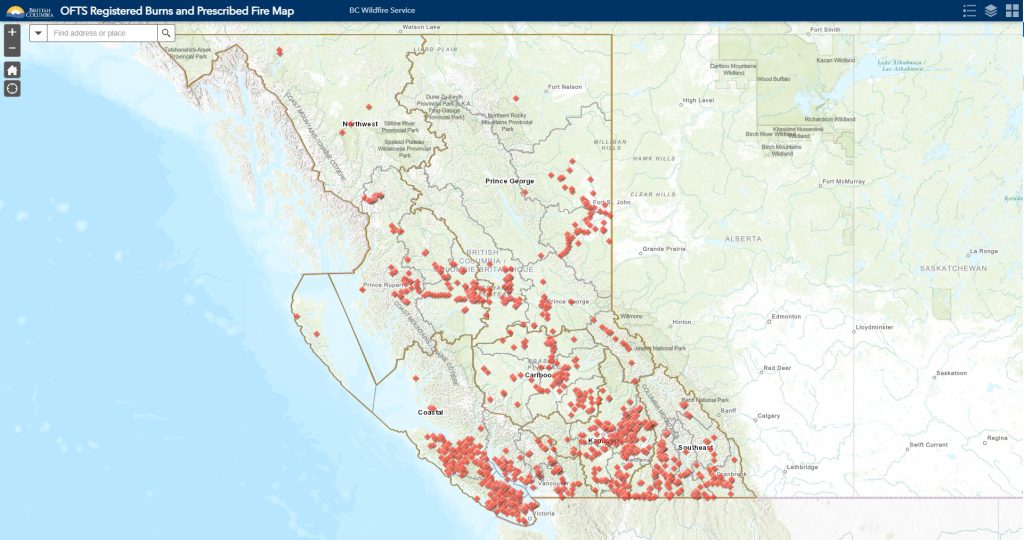In British Columbia it is common for grass fires to ignite and spread quickly in early spring. Typically, fine fuels remain quite dry in March and April, when daytime temperatures begin to increase but the snow remains at high elevations. While these dry conditions are favourable for prescribed fire and open burning, the risk and prevalence of human-caused wildfires increases as a result. As the province transitions into spring weather patterns, it is important to remember that much of the northeast and southwest regions of the province were experiencing drought conditions late into the fall last year, which may impact spring burning conditions.
Open burning can be a useful tool when conducted responsibly while it is permitted. If conducted irresponsibly or in unsafe conditions, the potential of a human-caused wildfire increases. Human-caused wildfires are completely preventable. Always practice safe, responsible fire use where permitted. If there are no open burning prohibitions established by the Province, it is important to check with local government authorities for any other open burning restrictions.
In early spring, most escaped open burns have one or all of the following factors in common:
- the burn has been left unattended (even for a very short duration)
- changes in wind behaviour
- poor venting conditions
In order to have a safe and successful burn:
- ensure an open burn is never left unattended
- use tools like windy.com (this includes local wind speeds and direction, and provides more detail than high-level weather forecasts – there is also a layer for windy.com data availabe in our mobile app)
- check the venting index
Learn more about what you need to know before lighting an open burn of any kind below.
Open burning is classified into four categories with separate criteria. To learn more specifically about Category 2 and Category 3 open fire, safety an responsibility, how to register and more continue reading below.
Category 2 Open Fire

This category refers to fires, other than a campfire, that burn:
- material in one pile not exceeding 2 metres in height and 3 metres in width
- material concurrently in 2 piles each must not exceed 2 metres in height and 3 metres in width
- stubble or grass over an area that does not exceed 0.2 hectares
Example: During the spring, farmers and ranchers may conduct controlled burns for agricultural purposes.
Category 3 Open Fire

This category refers to an open fire that burns:
- material concurrently in 3 or more piles each, not exceeding 2 metres in height and 3 metres in width
- material in one or more piles each exceeding 2 metres in height or 3 metres in width
, - one or more windrows (row of cut hay or woody materials or small grain crop) and/or stubble or grass over an area exceeding 0.2 hectares
Example: The forestry industry may conduct “slash” burning to remove wood debris left behind after timber harvesting.
Safety and responsibility
Always check with local authorities and weather conditions before lighting a fire of any size. Before lighting a fire, even if the burn category is not currently prohibited, ensure you are properly prepared, aware of the conditions and following open burning regulations:
- Establish a fuel break around your Category 2 or 3 burn or fire guard around your campfire.
- Ensure someone is always monitoring the fire so it doesn’t spread beyond its intended size. At least one person equipped with a fire-fighting hand tool and a fire suppression system must monitor the fire at all times.
- Do not burn when venting conditions are “Poor” or “Fair”.
Registering
A burn registration must be obtained by anyone lighting a Category 3 fire by calling 1 888 797-1717. These numbers are logged into the Open Fire Tracking System (OFTS) along with details about the registered burn. This makes it relatively easy to revoke or reinstate these registration numbers as local weather impacts fire danger.
Unsure if you need to register your burn? Want to know what your legal obligations are when open burning? The Government of BC has produced a series of pamphlets which detail safe practices and the regulations around open burning.
- Backyard & Industrial Burning – Category 2 (PDF, pamphlet)
- Industrial & Resource Management Burning – Category 3 (PDF, pamphlet)
- Open Burning Practices for Farmers and Ranchers (PDF, factsheet)
Open Fire Tracking System (OFTS)
Burn registration numbers are logged into the Open Fire Tracking System (OFTS) along with details about the registered burn. This system allows the BC Wildfire Service to track regulated burning across B.C., manage firefighting resources and minimize false reports of wildfires. Check if local burns are taking place in your area before reporting a suspected wildfire.

Reporting
To report a wildfire, unattended campfire or open burning violation, call 1 800 663-5555 toll-free or *5555 on a cellphone.
Did you know you can now report a wildfire using our BC Wildfire Service mobile app? Use the “Report a Fire” function to submit an electronic report and upload a photo. You must have data or a WiFi connection to submit a report. A video tutorial in the “Help” section explains how to report a fire in the app. Download the BC Wildfire Service Mobile App for free on all iOS (Apple) and Android devices.
